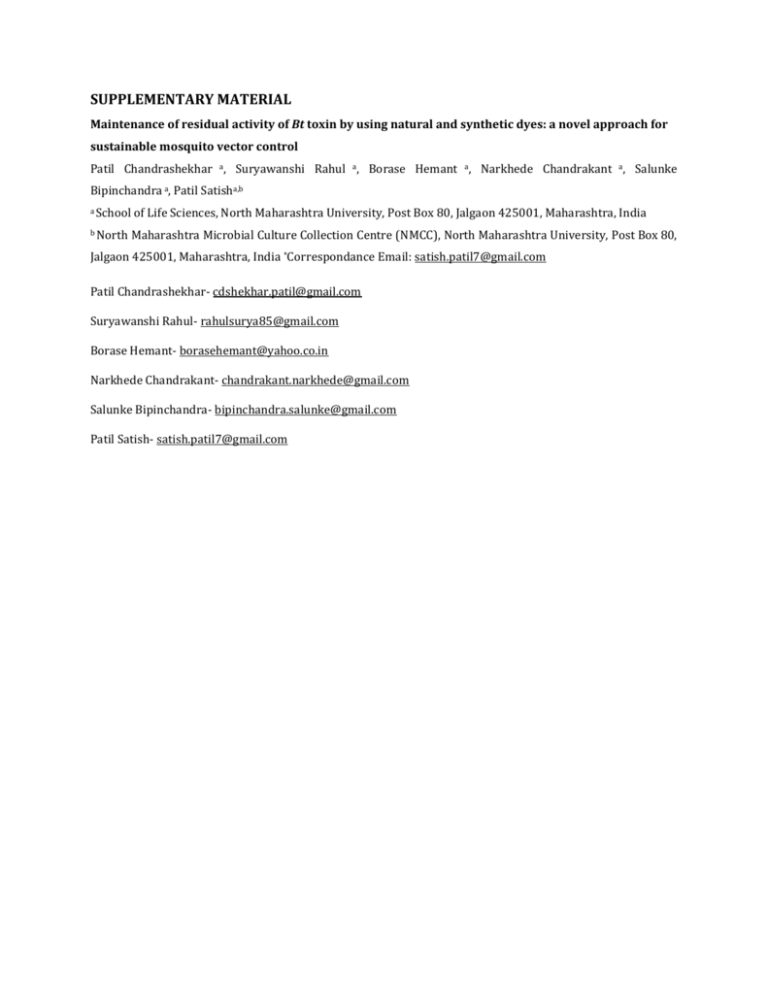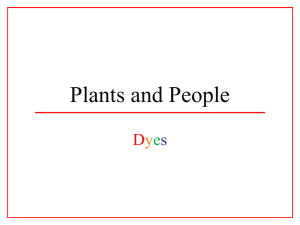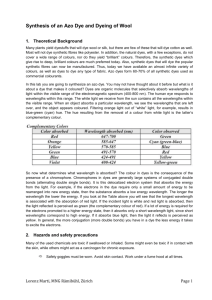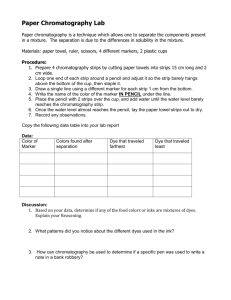SUPPLEMENTARY MATERIAL Maintenance of residual activity of Bt
advertisement

SUPPLEMENTARY MATERIAL Maintenance of residual activity of Bt toxin by using natural and synthetic dyes: a novel approach for sustainable mosquito vector control Patil Chandrashekhar a, Suryawanshi Rahul a, Borase Hemant a, Narkhede Chandrakant a, Salunke Bipinchandra a, Patil Satisha,b a School b North of Life Sciences, North Maharashtra University, Post Box 80, Jalgaon 425001, Maharashtra, India Maharashtra Microbial Culture Collection Centre (NMCC), North Maharashtra University, Post Box 80, Jalgaon 425001, Maharashtra, India *Correspondance Email: satish.patil7@gmail.com Patil Chandrashekhar- cdshekhar.patil@gmail.com Suryawanshi Rahul- rahulsurya85@gmail.com Borase Hemant- borasehemant@yahoo.co.in Narkhede Chandrakant- chandrakant.narkhede@gmail.com Salunke Bipinchandra- bipinchandra.salunke@gmail.com Patil Satish- satish.patil7@gmail.com Abstract Mosquito control protein from Bacillus thuringiensis get inactivated with exposure to sunlight. To address this issue, potential of synthetic and natural dye were investigated as sunlight protectants. Bt SV2 in absence of dyes when exposed to sunlight showed reduced effectiveness against the fourth instars of mosquito larvae. Whereas acriflavin, congo red and violacein were able to maintain 86.4, 91.6, and 82.2% mosquito larvicidal efficacy of Bt SV2 against IVth instars larvae of Anopheles stephensi Meigen after exposure to sunlight. Similarly, Beet root dye, acriflavin, congo red and violacein maintained 98.4, 97.1, 90.8 and 70.7% larvicidal activities against Aedes aegypti Linnaeus after sunlight exposure. Prodigiosin was found to be the best photoprotectant by simultaneously protecting and enhancing Bt activity by 6.16 and 22.16% against An. stephensi and Ae. aegypti, respectively. Combination of dyes with Bt formulations can be a good strategy for mosquito control programmes in tropical and sub-tropical regions. Key words: Bacillus thuringiensis; Bt SV2 dye photo-protectant; mosquito borne diseases control. 1. Experimental 1.1 Test materials and microorganisms Our isolate of B. thuringiensis (Bt SV2), previously reported for mosquito larvicidal properties was used for experimentation. Congo red, acriflavin dyes were purchased from HiMedia India Ltd. Prodigiosin and violacein were produced and extracted using our isolates of Serratia marcescens (NMCC 75) and Chromobacterium violaceum (KM226331) as per the previous report (Suryawanshi et al. 2014). Beta vulgaris (Amaranthaceae) was purchased from supermarket. Dye extract was prepared by taking 10 g of Beta vulgaris roots in grinder, followed by filtration through muslin cloth with pore size of 0.7 to 1.5 mm. The extract was lyophilized and quantified on dry weight basis. This dye was used as ‘Beet root dye’ for the experiments. 1.2 Treatment of dyes Spore-crystal aggregates of Bt SV2 were scrapped from nutrient agar plates after 7 days of incubation of spores. Congo red, acriflavin, violacein, prodigiosin and beet root dye were quantified on dry weight basis and 10 mg of each dye was dissolved in 10 mL distilled water. One mL of each dye was separately mixed with Bt SV2 spore toxin (200 mg wet spore toxin pellet was mixed in 3 mL water to prepare Bt SV2 spore toxin). The mixture was incubated for 12 hrs on shaker at 50 rpm for proper mixing. The suspension was then dialyzed overnight against distilled water to remove excessive dye. Finally mixtures of Bt toxin and dyes were lyophilized separately and used for experimentation. 1.3 Exposure to sunlight The lyophilized samples of Bt SV2 toxin and the combinations of Bt SV2 with different dyes were used to prepare 5 ppm toxin solutions in distilled water. The Bt SV2 samples without dyes were kept as controls. These sample solutions (25 mL) were kept in Petri plates and were exposed to sunlight up to 8 hours in the month of May (2013) with an average temperature 40°C. The exposure chambers were covered with glass cabinet to protect sample from contamination of dust particles. The spore suspensions without dyes kept in shade and sunlight were used as positive and negative controls, respectively. After exposure to sunlight the volume of sample solutions lost due to evaporation was maintained by addition of distilled water. The same method was followed for larvicidal bioassay and further analyses. The shade incubated Bt SV2 spores were used as control. Spore solution without dyes was also used as negative control to observe the effect of sunlight in inactivation of Bt toxin. 1.4 Spectroscopic analysis Bt toxin with and without dyes before and after sunlight irradiation for 8 hours were analyzed in UV Visible spectrophotometer (Shimadzu, Japan). Lyophilized samples of Bt SV2 with and without different dyes were mixed with KBr pellets and analyzed by Fourier transform infrared (FT-IR) spectroscopy using Testscan Shimadzu FT-IR 8400 (Shimadzu, Japan) at 4000 to 400 cm-1. 1.5 Mosquito larvicidal bioassay Mosquito larvae were maintained as per Patil et al. (2011). Fourth instar larvae of Ae. aegypti and An. stephensi were obtained from District Malaria Control Department, Jalgaon (21°2’54’ N, 76°32’3’ E; elevation, 209 m). The larvae were maintained in plastic enamel trays containing dechlorinated tap water. All the experiments were carried out at 28±2°C with 75–85% relative humidity under 14:10 light and dark cycles. Larvae were fed with diet of finely ground brewer’s yeast and dog biscuits (3:1). The potential toxicity of sunlight exposed toxin with and without dyes and unexposed toxin was assayed on early fourth instars larvae of A. aegypti and An. stephensi. Bioassays were performed using 1 mL of 2 ppm dose of Bt SV2 for 20 mosquito species in 100 mL of sterile distilled water. All assays were performed in triplicates. In all cases, the mortalities of control larvae were calculated by Abbott (1925) formula. %𝑀𝑜𝑟𝑡𝑎𝑙𝑖𝑡𝑦 = (1 − Where, n- larvae population 𝑛 𝑖𝑛 𝑐𝑜𝑛𝑡𝑟𝑜𝑙 𝑏𝑒𝑓𝑜𝑟𝑒 𝑡𝑟𝑒𝑎𝑡𝑚𝑒𝑛𝑡 X 𝑛 𝑖𝑛 𝑡𝑒𝑠𝑡 𝑎𝑓𝑡𝑒𝑟 𝑡𝑟𝑒𝑎𝑡𝑚𝑒𝑛𝑡 𝑛 𝑖𝑛 𝑐𝑜𝑛𝑡𝑟𝑜𝑙 𝑎𝑓𝑡𝑒𝑟 𝑡𝑟𝑒𝑎𝑡𝑚𝑒𝑛𝑡 X 𝑛 𝑖𝑛 𝑡𝑒𝑠𝑡 𝑏𝑒𝑓𝑜𝑟𝑒 𝑡𝑟𝑒𝑎𝑡𝑚𝑒𝑛𝑡 ) X 100 2. Results and discussion Figure S1: Time dependant loss of activity against Ae. aegypti, A:2h; B:4h; C:6h; D:8h Figure S2: Time dependant loss of activity against An. stephensi, A:2h; B:4h; C:6h; D:8h Figure S3. UV –visible spectrum of sunlight exposed (8hrs) BtSV2 toxin (control) and BtSV2 toxin with prodigiosin Figure S4. FT-IR of BtSV2 toxin (A) and toxin with prodigiosin dye (B) IUPAC names of the dyes used in the experiments: a) Congo red- sodium salt of 3,3'-([1,1'-biphenyl]-4,4'-diyl)bis(4-aminonaphthalene-1-sulfonic acid); b) Acriflavine- acridine-3,6-diamine; c) Prodigiosin- 4-Methoxy-5-((5-methyl-4-pentyl-2H-pyrrol-2-ylidene)methyl)-2,2'-bipyrrole d) Violacein- [3-(1, 2-dihydro-5-(5-hydroxy- 1H-indol-3-yl)-2-oxo-3H-pyrrol-3-ilydene)1,3dihydro-2H-indol-2-one] e) Beet root dye (betanin)- 4-(2-(2-carboxy-5-(beta-Dglucopyranosyloxy)-2,3-dihydro-6- hydroxy-1Hindol -1-yl)ethenyl)-2,3-dihydro-(S-(R*,R*))2,6-pyridinedicarboxylic acid; Glossary: Bt- Bacillus thuringenesis Bti- Bacillus thuringenesis israelinesis Bt SV2- Bacillus thuringenesis SV2 deposited to gene bank (JN315886) IR- Infra red FT-IR- Furrier transform infra red. References: Abbott WW. 1925. A method of computing the effectiveness of an insecticide. J. Econ. Entomol. 18(1):265267. Patil CD, Patil SV, Salunke BK, Salunkhe RB. 2011. Prodigiosin produced by Serratia marcescens NMCC46 as a mosquito larvicidal agent against Aedes aegypti and Anopheles stephensi. Parasitol Res 109:1179– 1187.







